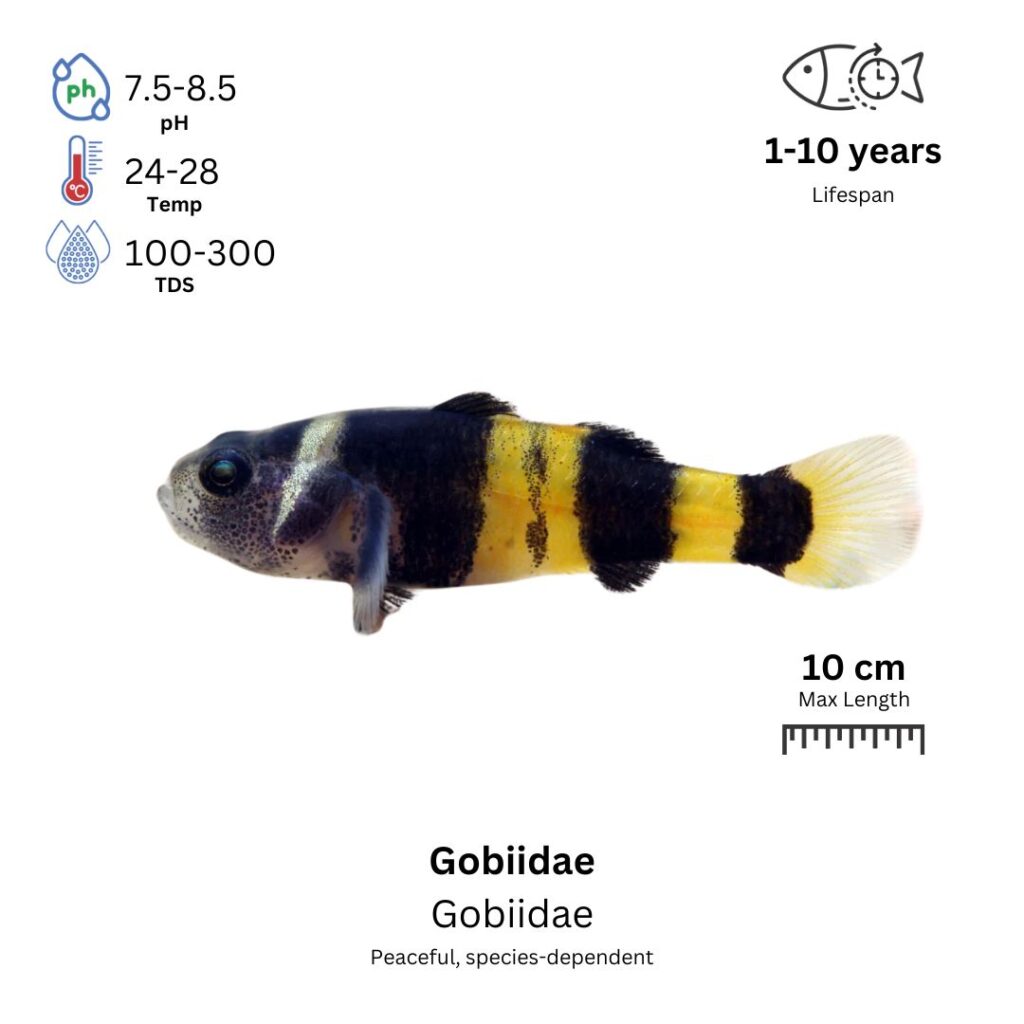Gobiidae
Gobiidae

Description
The family Gobiidae includes a large group of small to medium-sized fish commonly known as gobies. They have a compact body with a fused pelvic fin that forms a disc or sucker-like structure, which allows them to cling to rocks, coral, or the substrate. Gobies come in a wide variety of colors and patterns, but they typically have a cylindrical body with a flattened head and large eyes. Their behavior can vary depending on the species, but they are generally bottom-dwellers, often found in sand, mud, or rocky environments. Many gobies are known for their peaceful nature and can be great additions to community aquariums. Some species are even known to form symbiotic relationships with other creatures, such as shrimp, where they share burrows.
Habitat Origin
Gobiidae is a diverse family, with species found in both freshwater and marine environments. They are particularly common in the coastal waters of tropical and subtropical regions, but many species also inhabit freshwater rivers and streams, particularly in Asia, Africa, and the Americas. Marine gobies can be found along rocky shores, coral reefs, and sandy bottoms, while freshwater species are often found in slow-moving waters or muddy riverbeds.
Aquarium
Ideal Number in Aquarium: Many gobies are social fish and do well in small groups, but some species can be territorial and may need to be kept individually or with other non-aggressive species.
Favorite Food

Goby fish are omnivores and will accept a variety of foods. They typically feed on small invertebrates, detritus, and algae in the wild. In the aquarium, they can be fed high-quality flakes, pellets, live or frozen foods such as brine shrimp, bloodworms, and daphnia, and algae wafers. Some species may also nibble on small plant matter.
Behavior:
Gobies are generally peaceful but can be territorial depending on the species. They are bottom-dwellers and are often seen scurrying around the substrate, where they use their sucker-like fins to hold onto rocks, the aquarium bottom, or even plants. Some species of gobies are known to be symbiotic with other marine creatures like shrimp, where they share a burrow and protect each other. In aquariums, they may spend a lot of time hiding or burrowing, but they are usually quite active at night.
Special Care:
Goby fish typically do well in tanks with plenty of hiding places and stable water conditions. For marine gobies, a well-filtered tank with stable salinity is crucial, while freshwater gobies thrive in aquariums with clean, soft water and some natural substrate (sand or gravel). Some species may need a sand or gravel bed to burrow into. Regular water changes and a suitable filtration system will help maintain water quality.
Compatibility with Other Fish:
Gobies are usually compatible with other peaceful species, but it depends on the specific type of goby. Marine gobies generally do well with other non-aggressive fish, while freshwater species may need to be kept with similarly peaceful species. They are best housed with small to medium-sized tankmates that won’t harass them. Some species can be territorial, particularly during breeding, so it’s important to monitor interactions with other fish, especially in smaller tanks.
Breeding Tank Setup
A separate breeding tank is strongly recommended for Gobies due to their territorial nature and need for controlled water parameters. For most small freshwater species, a 10–20 gallon tank (38–75 liters) suffices, while larger species may require 30 gallons (113 liters) or more. Maintain pH between 6.5–8.0, temperature from 22–28°C (72–82°F), and hardness of 5–15 dGH. Use gentle filtration like a sponge filter to avoid strong currents. Add fine gravel or sand as substrate, along with plants like Java moss and rock caves to simulate natural hiding and spawning sites. Lighting should be moderate, with a 12-hour light/dark cycle to mimic natural conditions.
Conditioning Breeding Pairs
To prepare Gobies for breeding, provide a varied, high-protein diet that includes live or frozen foods (brine shrimp, daphnia, bloodworms), quality pellets or flakes, and some vegetable-based items like algae wafers or chopped spinach. A nutritious diet enhances health and spawning readiness. Perform weekly 20–30% water changes, and simulate breeding conditions by doing a larger 50% water change and slightly increasing the temperature. This mimics seasonal rainfall patterns and can trigger courtship behavior.
Spawning Behavior
Gobies may spawn in the morning or after environmental cues like a water change. Males often establish territory and attract females to spawning sites, which may be open surfaces, substrate, or inside caves, depending on the species. Females lay 20 to several hundred eggs, which are adhesive and stick to surfaces. In many species, the male guards and fans the eggs until they hatch, but if egg predation is observed, consider removing the parents to protect the clutch.
Fry Development & Feeding
Eggs hatch in 3–7 days, depending on species and water temperature. Newly hatched fry begin swimming and feeding shortly after exhausting their yolk sacs. Start them off with infusoria or liquid fry food, then gradually introduce baby brine shrimp, microworms, or fine powdered fry food as they grow. Maintain stable, clean water with daily small water changes (10–20%) and consistent temperature. Avoid overfeeding, as poor water quality can quickly harm the sensitive fry.
Additional Tips for Success
Most Gobies reach breeding maturity at 6–12 months, but species-specific variation exists. Males are often more colorful and slender, sometimes with extended fins, especially during breeding. Females tend to be rounder and larger. Avoid stress from sudden water changes, poor filtration, aggressive tank mates, or overcrowding. A peaceful, species-appropriate setup with stable parameters is key to long-term breeding success and fry survival.
